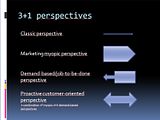All in all, I think Christensen and Raynor have a solid perspective that deserves further observation. All businesses have long been seeking to become customer-oriented or customer-driven - many have succeeded while others have failed. But if companies adopt their perspective, do they face the risks of innovative stagnation and hampered business development caused by customer-overdrive? In many industries, small subcontractors and suppliers who chose to specialize in serving certain customers have hit rock bottom after these customers no longer continued business with them for varying reasons. They were customer-overdriven, and went bust because of it. These businesses had been entangled in processing and handling the current needs of their customers and had dismissed their own business development and innovation work.
Considering the different perspectives and these risks, I came up with this diagram, four perspectives to defining your business.

The diagram shows the classic perspective (aka "we're in the oil business and supply our customer with petroleum"), Levitt's marketing myopic (if you may) perspective, Christensen and Raynor's perspective and a fourth, Proactive customer-oriented perspective.
The fourth perspective is an attempt to fuse the best sides of myopic and demand-based perspectives. The myopic perspective's one groundbreaking advantage is that it expands the innovative horizon of the company - by defining business this way, new growth options become visible for innovative executives. Demand-based perspective's advantage is naturally customer-orientation. Combining these we achieve a viewpoint where we are customer-driven, grow as our customers grow, but also consider the larger horizon of business opportunities. Being customer-driven should not translate to being too focused in day-to-day customer demand satisfaction and to dismissing real out-of-the-box thinking and proactive satisfaction of hidden demands. While explicit and tacit information from customer and their ever-changing needs are essential for companies, they should not rely on them only, but keep a myopic perspective on their own business aswell. By doing so, they can enjoy being customer-oriented but evade risks mentioned above - and escape the danger of customer overdrive.

